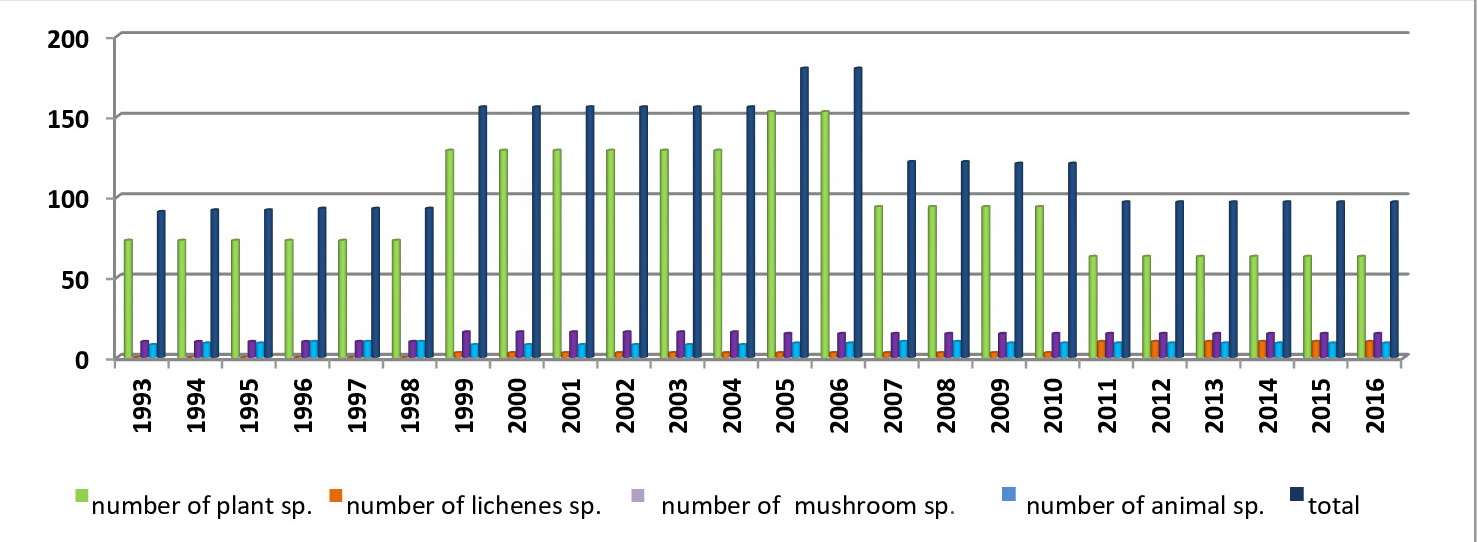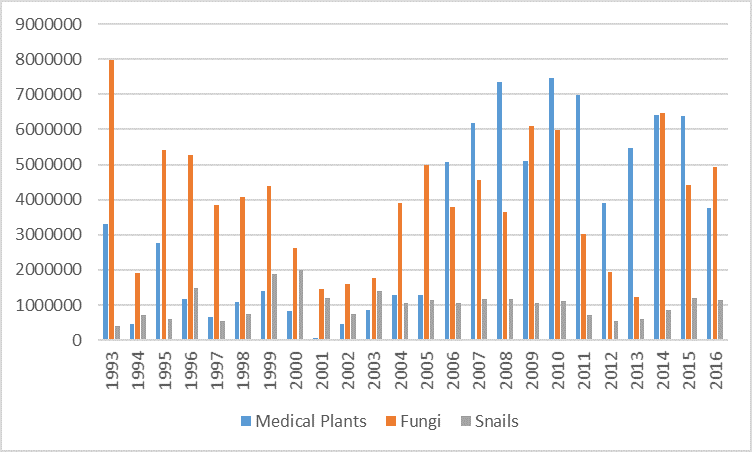Key message: Use of wild flora and fauna increases
Assessment: In addition to cultivated plant types, overall agro-biodiversity of Serbia also includes wild plant species that represent important components of food production and agriculture (forage crops, medical and aromatic herbs, decorative plants, honey plants, wild fruit). Various agro-ecosystems (arable farms, orchards, vineyards, meadows, pastures, brink and ruderal habitats) and components thereof, also contribute to overall agro-biodiversity of Serbia.
The diversity of species that dwell in natural fields (meadows and pastures) has not been well studied or estimated, but number of species within the described 273 plant associations has been estimated at more than 1,000. Total number of medical and aromatic plant species in flora of Serbia is about 700, 280 of which are traded as commodities. Honey plants are primarily found in meadow, forest and agro-ecosystems, and their number in our country has been estimated at approximately 1,800.
Areas under forests in Serbia include combination of deciduous forest (beech and oak), in the percentage of about 60.7%, coniferous forests, in the percentage of 4.7%, and mixed deciduous-coniferous forests, covering 33 % of the area. With regard to autochthonic forest genetic resources, greatest value is seen in endemic and endemo-relict species (Pinus peuce, Pinus heldreichii, Pinus nigra ssp. gocensis, Picea omorika, Taxus baccata, Prunus laurocerasus, Acer heldreichii, Fraxinus pallisae, Forsythia europaea, Corylus colurna, Daphne blagayana, Daphne mesereum and others). Within forest genetic resources, in addition to the natural rarities, great importance is given to wild fruit species. Eighty-eight species of wild fruit have been identified within the natural forest associations of Serbia, 12 of which are endangered species.
Among genetic resources of medical and aromatic herbs, greatest importance is given to genetic diversity of commercially important species (chamomile, mint, sage, hypericum, yarrow, oregano, bearberry, valerian, plantain, primula, etc.), as well as to sorts of limited areas and to those that are for some reason endangered. Looking at the genetic resources of medical and aromatic herbs and the need for their conservation, coordinated monitoring activity, which would look into the status of their populations, has not been implemented for a long time, while general conservation strategy at national and international levels have not been developed yet. This is one of the main reasons for the recommendation related to establishment of ECPGR Working Group for Medical and Aromatic Herbs (1999).
The wild relatives are of particular importance as genetic resource in improving and selecting cultivated plants, especially at the level of resistance to various abiotic and biotic stressful external factors. More than a half of cultivated plants have direct relatives within forest and herbaceous plant associations. As far as it is known, there have been no attempts to develop inventory and perform characterisation of these genetic resources in our country, except for wild relatives of fruit species.
The collection of medicinal herbs shows upward trends starting from 2004, the quantities of mushrooms collected are constantly increasing and are conditioned by weather conditions (whether the year is good for mushrooms or not), snails are kept constant on quantities approved, while frogs over the past 5 years have not been collected because excessive collecting has damaged the age structure of populations, so there are not enough adult individuals in the wild. Weather conditions by years (bad year for mushrooms due to the great dry season, the same goes for snails, some years are bad for juniper because it does not yield every year, the dry season affects the quantity and quality of medicinal herbs .
The collection and placing on the market of wild species of plants, mushrooms and animals has been legally regulated in Serbia since 1993, by the Order on putting control of the use and trade of wild plant and animal species (“Official Gazette of RS” No. 50/93 and 36/94). Today, permits for the collection and trade of wild plants, mushrooms and animals are issued on the basis of the Regulation on the control of the use and trade of wild flora and fauna (“Official Gazette of RS” No. 31/05, 45/05, 22/07, 38/08, 9/09 and 69/11), and the permits are issued by the Ministry of Environmental Protection, based on the opinion of the Institute for Nature Conservation of Serbia.
By processing the data collected during 24 years, it has been established that the regulations from 1993-2016 included a total of 179 wild medicinal plant species, of which today with the control of collection and trade, 63 are included. Analysis of the data for the stated 24-year period, it was established that 50 types of plants from 1993 to 2016 were collected in quantities of more than 10,000 kg per year, depending on the year of collection. Of these, 36 types of plants are still under the control of collection and trade, and 14 species are removed from the list of regulations even though quantities collected are significant. The number of taxa (species and genus) of mushrooms covered by the control of the use and trade of wild flora and fauna in the period 1993-2016 amounted to 21 (19 species and 2 genera: Agaricus spp. Button mushroom and Morshella spp. True morrel). Mushrooms are traditionally collected in southeast, central and western Serbia.


Indicator Name: Collection of wild flora and fauna
Institution/Author: University Futura/dr Radomir Mandić, Environmental Protection Agency/Slaviša Popović
Use and interpretation:
The Indicator shows level of uses of wild flora and fauna
Key question(s) which indicator helps to answer
What is the level of exploitation of wild flora and fauna in Serbia? Are wild flora and fauna used in sustainable way?
Use of indicator
In addition to cultivated plant types, overall agro-biodiversity of Serbia also includes wild plant species that represent important components of food production and agriculture (forage crops, medical and aromatic herbs, decorative plants, honey plants, wild fruit). Various agro-ecosystems (arable farms, orchards, vineyards, meadows, pastures, brink and ruderal habitats) and components thereof, also contribute to overall agro-biodiversity of Serbia.
Among genetic resources of medical and aromatic herbs, greatest importance is given to genetic diversity of commercially important species (chamomile, mint, sage, hypericum, yarrow, oregano, bearberry, valerian, plantain, primula, etc.), as well as to sorts of limited areas and to those that are for some reason endangered. Looking at the genetic resources of medical and aromatic herbs and the need for their conservation, coordinated monitoring activity, which would look into the status of their populations, has not been implemented for a long time, while general conservation strategy at national and international levels have not been developed yet.
Scale of appropriate use
The diversity of species that dwell in natural fields (meadows and pastures) has not been well studied or estimated, but number of species within the described 273 plant associations has been estimated at more than 1,000. Total number of medical and aromatic plant species in flora of Serbia is about 700. Out of these, 280 are traded as commodities. Honey plants are primarily found in meadow, forest and agro-ecosystems, and their number in our country has been estimated at approximately 1,800.
Potential for aggregation:
Meaning of upward or downward trends (“good or bad”)
The wild relatives are of particular importance as genetic resource in improving and selecting cultivated plants, especially at the level of resistance to various abiotic and biotic stressful external factors. More than a half of cultivated plants have direct relatives within forest and herbaceous plant associations. As far as it is known, there have been no attempts to develop inventory and perform characterisation of these genetic resources in our country, except for wild relatives of fruit species.
The collection of medicinal herbs shows upward trends starting from 2004, the quantities of mushrooms collected are constantly increasing and are conditioned by weather conditions (whether the year is good for mushrooms or not), snails are kept constant on quantities that are approved, while frogs have not been collected over the last 5 years because the excessive collecting had damaged the age structure of populations, so there are not enough adult individuals in the wild. Weather conditions by years (bad year for mushrooms due to the great dry season, the same goes for snails, some years are bad for juniper because it does not yield every year, the dry season affects the quantity and quality of medicinal herbs.
Possible reasons for upward or downward trends:
Since 1993, the collection and placing on the market of wild species of plants, mushrooms and animals has been legally regulated in Serbia, by the Order on putting control of the use and trade of wild plant and animal species (Official Gazette of RS No. 50/93 and 36/94). Today, permits for the collection and trade of wild plants, mushrooms and animals are issued on the basis of the Decree on the Control of the Use and Trade of Wild Flora and Fauna (Official Gazette of RS No. 31/05, 45/05, 22/07, 38/08, 9/09 and 69/11), and the permits are issued by the Ministry of Environmental Protection, based on the opinion of the Institute for Nature Conservation of Serbia.
Implications for biodiversity management of change in the indicator:
By processing the data collected during 24 years, it has been established that the regulations from 1993-2016 included a total of 179 wild medicinal plant species, of which 63 are included today with the control of collection and trade. Analysing the data for the stated 24-year period, it was established that 50 types of plants from 1993 to 2016 were collected in quantities of more than 10,000 kg per year, depending on the year of collection. Of these, 36 types of plants are still under the control of collection and trade, and 14 species are removed from the list of regulations even though quantities collected are significant.
Units in which it is expressed:
kg per year, number of samples per year
Description of source data:
Ministry of Environmental Protection, Institute for Nature Conservation
Calculation procedure:
By processing the data collected during 24 years, it has been established that the regulations from 1993-2016 included a total of 179 wild medicinal plant species, of which 63 are included today with the control of collection and trade.
Most effective forms of presentation:
(graph types, maps, narratives, etc.-give examples where possible):
The best ways to present this indicator are graphs and tables.
Limits to usefulness and accuracy:
Access to data for analysis
Updating the indicator:
Annually
Closely related indicators
Export of wild flora and fauna
Additional information and comments
Table: Trend of colected medical plants, mushrooms and snails in Serbia
| Medical Plants | Fungi | Snails | |
| 1993 | 3303975 | 7984320 | 411100 |
| 1994 | 456130 | 1904585 | 725500 |
| 1995 | 2769852 | 5418783 | 600000 |
| 1996 | 1165559 | 5275312 | 1479982 |
| 1997 | 666250 | 3857860 | 545000 |
| 1998 | 1075426 | 4086410 | 740000 |
| 1999 | 1410432 | 4393633 | 1872785 |
| 2000 | 837374 | 2621420 | 2000000 |
| 2001 | 70474 | 1441512 | 1198000 |
| 2002 | 457471 | 1610685 | 743803 |
| 2003 | 844325 | 1770233 | 1384000 |
| 2004 | 1273190 | 3905492 | 1052152 |
| 2005 | 1272550 | 4985927 | 1130152 |
| 2006 | 5070140 | 3779765 | 1050000 |
| 2007 | 6174402 | 4563062 | 1171550 |
| 2008 | 7341631 | 3635755 | 1160000 |
| 2009 | 5093193 | 6089120 | 1065000 |
| 2010 | 7450810 | 5978610 | 1110000 |
| 2011 | 6984999 | 3032780 | 711000 |
| 2012 | 3898904 | 1939752 | 529500 |
| 2013 | 5485124 | 1238689 | 596000 |
| 2014 | 6396881 | 6455675 | 845000 |
| 2015 | 6375153 | 4412998 | 1193000 |
| 2016 | 3748598 | 4927314 | 1150000 |
Serbia